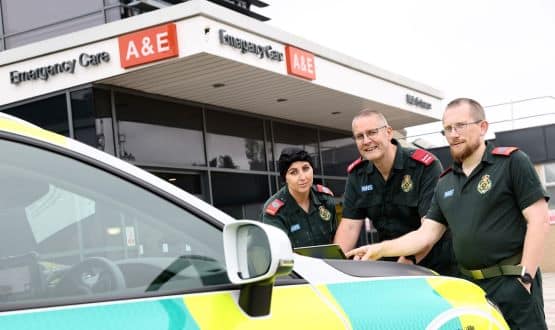GDEs should remove need for procurements, says Swindells
- 7 July 2017

The global digital exemplar and accompanying fast follower programme will be used to fundamentally change how NHS trusts buy IT systems, potentially removing the need for future procurements.
One of NHS England’s most senior directors suggested that if the GDE programme goes well, it will result in a ‘blueprint’ cookie cutter model for other trusts to follow, and end the need for competitive public procurements.
Matthew Swindells, NHS England’s national director for operations and information, told the iLinks conference on Wednesday, 5 July, that the GDE programme will lead to a change in the procurement model used by the NHS.
“At the core of the GDE model is the idea that we should be learning from each other. If the GDE and fast follower model goes well in the future, nobody will run procurements to buy IT systems again.”
Instead, he said they would pick from an existing proven blueprint to follow: “They will run an evaluation and decide who they want to partner with.”
The GDE scheme is NHS England’s flagship initiative, where the country’s most digitally advanced trusts are getting central funding, to become templates for others to follow. To date, 16 acute GDEs and seven mental health GDEs have been announced, who are expected to each receive £10m and £5m respectively.
The GDEs are expected to produce best practice and technical guidance blueprints for other trusts to follow, and have fast follower trusts who partner and learn from them and receive a smaller portion of central funding.
Speaking to Digital Health News after his keynote, Swindells said that “by default” trusts would deploy the same IT system that its chosen exemplar used “rather than I’m running a procurement for an IT system, so it’s really turning the model round”.
However, this would need to be squared with current procurement regulations, requiring competitive tenders or use of previously negotiated framework contracts.
The Crown Commercial Service is responsible for the legal framework for public sector procurement. The government’s website says the over-riding policy requirement is that public procurement must be based on value for money, and “this should be achieved through competition, unless there are compelling reasons to the contrary”.
Swindells said: “We need to make sure that that’s done in an open and transparent and competitive way that complies with the procurement regulations”.
“It’s really to try and change the model and say ‘one NHS’ and how do we partner, how do we create a mixed market of vendors.”
“We’re not trying to do the national programme [NPfIT] and standardise IT systems”, he said, but wants to lower the costs of procurement and implementation.
Speaking to the iLinks audience in Liverpool, Swindells said the NHS is poor at replicating its successes, but that the GDE model intends to change that.
“One of the things that the NHS is dreadful at is spreading when you’re successful”, he said, “if we’re going to break through, if we’re going to do so in a way we can afford to do, we’ll have to find what works and spread it more effectively”.
“The whole GDE model is built around the idea that we will learn together, we will get better at it and then we will spread.”
At iLinks the chief executives from Alder Hey Children’s NHS Foundation Trust, Mersey Care NHS Foundation Trust, Royal Liverpool and Broadgreen University Hospitals NHS Trust and Wirral University Teaching Hospital NHS Foundation Trust, also spoke, detailing their GDE plans.
Louise Shepherd, chief executive at Alder Hey, announced that The Clatterbridge Cancer Centre NHS Foundation Trust, would be the children’s hospital’s fast follower.
Both specialist trusts use Meditech for their IT systems.
David Allison, chief executive at Wirral, said that Countess of Chester Hospital NHS Foundation Trust, would be its first fast follower. He added that the trust was working with the other Cerner GDEs to deliver the digital ambitions.
ILinks, organised by NHS Informatics Merseyside, was attended by about 600 people to showcase digital health across the Liverpool region. The area has the highest concentration of GDEs in the country, with four trusts being selected.
NHS England chose not to comment further on this story.





16 Comments
Sounds like a hammer to crack an imaginary walnut.
As Dave Kelsall says, write a decent business case & O.B.S and half your procurement “battle” is over.
The most difficult procurements are always the most half-a**ed and invariably bring problems further down the line, with huge maintenance invoices and such like, appearing from “nowhere”
“I want what they’ve got” will have monopoly suppliers rubbing their hands with glee
I think there is a “baby, bath water” issue here – we still need suppliers to be accountable and we all know (NPfIT) that if we marry in haste we will be repenting at leisure…
Geoffrey, completely agree. Every organisation is different and this could result in Trusts removing a number of good existing systems in-order to follow their neighbouring trusts larger IT system because it worked for them.
Large IT vendors that dominate the market may begin to spread without procurement and accountability as they once did in the NPfIT.
Good idea, I wonder what happens if the ecosystem of your local IT systems differs to that of the GDE’s and the systems you have are in direct competition to those of the GDE’s? I do accept you should be able to find one GDE who has the same system as you, however the finer details are yet to be thought through.
Where i see this working, is if you can find a compatible system at a GDE you can evidence clearly a route towards paper-free. My fear is the GDE’s will have funding to get to the latest version of software and what happens when non-GDE’s have to upgrade to conform.
Daniel, you are probably right, I am not quite as Cynical as Peter but without some governance in place high value procurements for ICT could be subject to such “incentives” ! Whilst Clive is right about ICT helping relive bureaucracy it also breeds its own new forms and a whole IG industry is going to expand to cover GDPR. I know it is an essential part of good data governance and control but I foresee a very under resourced approach to GDPR that will further delay ICT improvements in the NHS and Social Care.
Where’s the evidence for this?
Good IT and bureacracy aren’t mutually exclusive. The bureacracy is there to help prevent rogue CEOs and others from buying systems their Trusts either don’t need or can’t afford. In my first NHS job I was told that every PC I bought meant one fewer hip replacement that year. Perhaps not a fair comment but the point was that we were there to deliver healthcare and that if the IT didn’t help improve efficiency and effectiveness it was a drain on our limited resources.
The efficiencies of this approach lie not in the IT, or simpler procurements, but in sharing best practice in the implementation of common systems and the improvements in improved clinical effectiveness and efficiency that these enable – overcoming the “not invented here” resistance to change
Not a fair comment, no, (who told you? a clinician?, a manager?, I doubt it was technician), but an easy one to make (lets be honest, talking is easy, doing is hard). If the techie was able to use the new PC to crunch DATA, to provide insight to management which could reduce the Trusts RTT times by 5%, think of the benefIT to all the patients that the trust serves.
insight is all about sharing the info. that is important (info. is crunched data and do it well you need a good PC). When I worked at the South Central SHA, the batteries in the laptops lasted about 10 mins and there was one power lead for 3 laptops. Do you think a health consultant working in different care settings and relies on a laptop would (have to) put up with that ?
It was the Finance Director, explaining why every purchase had to have good supporting evidence that it would help either realise efficiencies or improve effectiveness. Someone in Whitehall saying that a procurement approved by central government offers good value for money so the usual procurement processes can be avoided won’t be sufficient evidence to get past a trust’s Audit Committee, let alone Parliament’s Public Accounts Committee, without solid evidence of Benefits Delivered by the GDE first implementers. Historically NHS Trusts, NHS England, the old DH and arms length bodies such as the HSCIC, CfH and NPfIT have not been good at providing evidence of benefits actually delivered, rather than forecast. Part of the problem is the constant structural changes in the way the NHS is managed and governed with ephemeral arms length bodies being disbanded before the projects they initiate have reached maturity and tangible benefits have been identified.
Further structural changes are required. The proces to justify a power lead – email, form, email, wait, chase, email blah blah … petty, whatever happened to petty cash ? Further simplification is required.
Further simplification is required.
Dave – nail on several heads there to put it mildly!
Good IT is replacing the bureaucracy and making things more efficient.
Let’s not be too hasty about Brexit and what might happen. Despite urban myth, “Europe” has little to do with the law as far as procurement in the UK public sector is concerned; the only (main) thing as far as “Europe” is concerned is that in respect of tenders, potential suppliers in every country in the EU are allowed to tender.
The relevant (UK) legislation is “The Public Contracts Regulations 2015”, and that won’t change one iota after Brexit. Procurements which the public sector (including the NHS) undertake will continue to be subject to those Regulations. It’s possible, even likely that the mandatory requirement to advertise procurements in the Official Journal of the European Union may no longer be necessary but the public sector will still be required to abide by “The Public Contracts Regulations 2015”, unless and until those Regulations are repealed .
Agreed. If you work for a Trust whose Standing Financial Instructions demand three competitive tenders for all procurements over say £20,000 – you are unlikely to get the go-ahead for a GDE fast follower contract worth tens of millions. The 2015 Regs remain in force regardless of Brexit.
Sadly from a legal perspective, we do not have “one NHS” but several hundred legally independent organisations each with its own SFIs and processes.
Under NPfIT we had National call off contracts for hardware and software. Some Trusts bought at the advertised “set price” trusting this delivered value for money but the more canny of us used those prices as the startng point for a competitive tender and saved our Trusts a small fortune wih each procurement.
There are some excellent framework contracts out there but Trust Boards are legally required to ensure VfM is delivered and this is done via the Business Case Process. If you take into account the overall business case, including staff re-training and disruption to clinical services, sticking to an incumbent supplier’s EHR can look unexpectedly attractive to a Trust Board.
I sincerely hope this initiative gets off the ground but a certain Mr Granger discovered that what seemed straightforward in Whitehall was extremely complicated at local level due to the fragmented nature of the NHS and the legally constituted independenc of each NHS organisation.
There are ways to speed up procurement now using G-Cloud and other frameworks. If the GDEs with CCS are establishing the procurement frameworks ready for other Trusts to copy then that would be good. If they have not done this then we will still be mired in the world of public sector procurement. It is worthy of note however that often internal NHS processes and local politics around approvals slow down procurements too.
I wonder what the UK will replace OJEU with when we have BREXIT? hopefully nothing and let the NHS get on with less red tape.
Good luck with this approach given our need to be cooperative in upcoming WTO and trade talks and the value of the NHS market
Comments are closed.